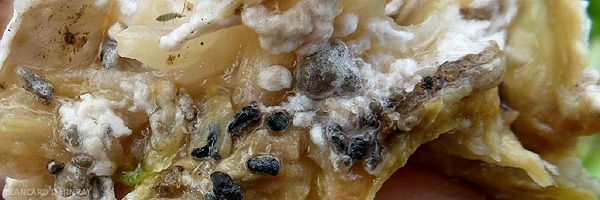
Sclerotinia sclerotiorum (Lib.) de Bary (1884)
Sclerotinia minor Jagger (1920)
Watery soft rot
- classification : Fungi, Ascomycota, Leotiomycetes, Leotiomycetidae, Helotiales, Sclerotiniaceae
- English names: Sclerotinia drop, Watery soft rot
Sclerotinia sclerotiorum and Sclerotinia minor are two fairly polyphagous ascomycetes . They are widespread and their damage has been reported in all production regions of the world: Australia, New Zealand, Japan, China, United States, Canada, Europe (Belgium, Netherlands, Germany, Spain, Italy, England, Portugal ...), Mediterranean basin (Israel, Turkey ...). The economic losses recorded in some countries are sometimes significant. In the United States for example, damage can fluctuate from plot to plot from less than 1% of diseased plants up to 75%.
In France , the situation is quite comparable. These 2 fungi are rampant with varying degrees of severity in many plots, alone or in association with other fungi such as Botrytis cinerea .
They are able to attack salads, both in nurseries and in the field. They are considered, in many countries, to be serious pathogens for all types of salad. They can live together in the same plot, but generally one or the other predominates in a given site.
- English names: Sclerotinia drop, Watery soft rot
Sclerotinia sclerotiorum and Sclerotinia minor are two fairly polyphagous ascomycetes . They are widespread and their damage has been reported in all production regions of the world: Australia, New Zealand, Japan, China, United States, Canada, Europe (Belgium, Netherlands, Germany, Spain, Italy, England, Portugal ...), Mediterranean basin (Israel, Turkey ...). The economic losses recorded in some countries are sometimes significant. In the United States for example, damage can fluctuate from plot to plot from less than 1% of diseased plants up to 75%.
In France , the situation is quite comparable. These 2 fungi are rampant with varying degrees of severity in many plots, alone or in association with other fungi such as Botrytis cinerea .
They are able to attack salads, both in nurseries and in the field. They are considered, in many countries, to be serious pathogens for all types of salad. They can live together in the same plot, but generally one or the other predominates in a given site.





